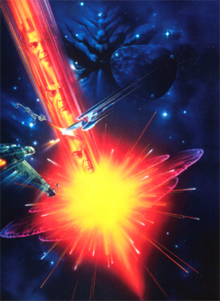
Back Star Trek VI: The Undiscovered Country AN ستار تريك السادس: البلد غير المكتشف Arabic ستار تريك السادس : البلد غير المكتشف ARZ Зорны шлях VI: Не адкрытая краіна Byelorussian Стар Трек VI: Неоткритата страна Bulgarian Star Trek: The Undiscovered Country Catalan Star Trek VI: Neobjevená země Czech Star Trek VI: The Undiscovered Country Welsh Star Trek VI: The Undiscovered Country Danish Star Trek VI: Das unentdeckte Land German
| Star Trek VI: The Undiscovered Country | |
|---|---|
 Theatrical release poster art by John Alvin | |
| Directed by | Nicholas Meyer |
| Screenplay by |
|
| Story by | |
| Based on | Star Trek by Gene Roddenberry |
| Produced by | |
| Starring | |
| Cinematography | Hiro Narita |
| Edited by | Ronald Roose |
| Music by | Cliff Eidelman |
Production company | |
| Distributed by | Paramount Pictures |
Release date |
|
Running time | 110 minutes[1] |
| Country | United States |
| Language | English |
| Budget | $30 million[2][3] |
| Box office | $96.8 million[4] |
Star Trek VI: The Undiscovered Country is a 1991 American science fiction film directed by Nicholas Meyer, who also directed the second Star Trek film, The Wrath of Khan. It is the sixth feature film based on the 1966–1969 Star Trek television series. Taking place after the events of Star Trek V: The Final Frontier, it is the final film featuring the entire main cast of the original television series. The destruction of the Klingon moon Praxis leads the Klingon Empire to pursue peace with their longtime adversary, the Federation; the crew of the Federation starship USS Enterprise must race against unseen conspirators with a militaristic agenda.
After the critical and commercial disappointment of The Final Frontier, the next film was initially planned as a prequel, with younger actors portraying the crew of the Enterprise while attending Starfleet Academy. The idea was discarded because of negative reaction from the original cast and the fans. Faced with producing a new film in time for Star Trek's 25th anniversary, director Nicholas Meyer and Denny Martin Flinn wrote a script based on a suggestion from Leonard Nimoy about what would happen if "the Wall came down in space", touching on the contemporary events of the Cold War.
Principal photography took place between April and September 1991. Because of a lack of sound stage space on the Paramount lot, many scenes were filmed around Hollywood. Meyer and cinematographer Hiro Narita aimed for a darker and more dramatic mood, altering sets that were being used for the television series Star Trek: The Next Generation (some of which had originally been built for Star Trek: The Motion Picture and used in subsequent films before being repurposed for the series). Producer Steven-Charles Jaffe led a second unit to an Alaskan glacier that stood in for a Klingon gulag. Cliff Eidelman produced the film's score, which is intentionally darker than previous Star Trek offerings.
Star Trek VI: The Undiscovered Country was released in North America on December 6, 1991. It garnered positive reviews, with publications praising the lighthearted acting, setting and facetious references, and performed strongly at the box office. It posted the largest opening weekend gross of the series before going on to earn $96.8 million worldwide.[4] The film earned two Oscar nominations, for Best Makeup and Best Sound Effects, and is the only Star Trek movie to win the Saturn Award for Best Science Fiction Film. The film has been released on various home media formats, including a special collectors' edition in 2004, for which Meyer made minor alterations to the film.
- ^ "Star Trek VI – The Undiscovered Country (PG)". British Board of Film Classification. December 12, 1991. Archived from the original on January 28, 2015. Retrieved May 22, 2013.
- ^ Greenberger, Robert (2012). "Star Trek: The Complete Unauthorized History". Voyageur Press. ISBN 9780760343593. Retrieved February 7, 2009.
- ^ Hauk, Dennis, Captain Quirk (1995), p. 212
- ^ a b "Star Trek VI: The Undiscovered Country (1991)". Box Office Mojo. Archived from the original on May 14, 2009. Retrieved March 11, 2010.